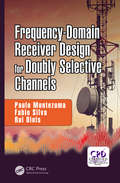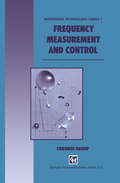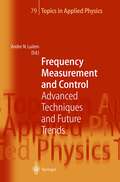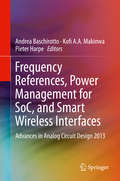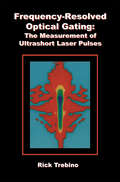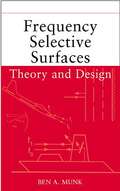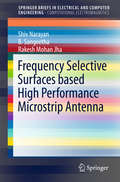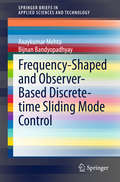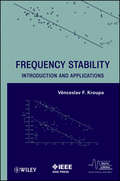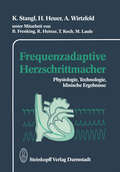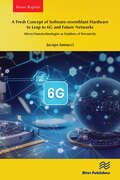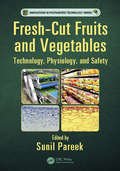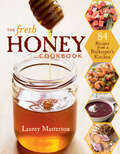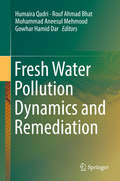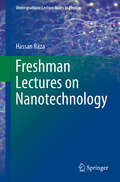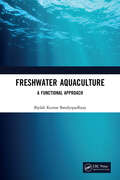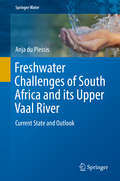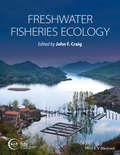- Table View
- List View
Frequency-Domain Receiver Design for Doubly Selective Channels
by Paulo Montezuma Fabio Silva Rui DinisFrequency-Domain Receiver Design for Doubly-Selective Channels discusses broadband wireless transmission techniques, which are serious candidates to be implemented in future broadband wireless and cellular systems, aiming at providing high and reliable data transmission and concomitantly high mobility. This book provides an overview of the channel impairments that may affect performance of single carrier and multi-carrier block transmission techniques in mobile environments. Moreover, it also provides a new insight into the new receiver designs able to cope with double selectivity that affects present and future broadband high speed mobile communication systems.
Frequency-Domain Receiver Design for Doubly Selective Channels
by Fabio Silva Paulo Montezuma Rui DinisFrequency-Domain Receiver Design for Doubly-Selective Channels discusses broadband wireless transmission techniques, which are serious candidates to be implemented in future broadband wireless and cellular systems, aiming at providing high and reliable data transmission and concomitantly high mobility. This book provides an overview of the channel impairments that may affect performance of single carrier and multi-carrier block transmission techniques in mobile environments. Moreover, it also provides a new insight into the new receiver designs able to cope with double selectivity that affects present and future broadband high speed mobile communication systems.
Frequency Measurement and Control (Microwave and RF Techniques and Applications #7)
by Chronos GroupPeriodical phenomena or, more precisely, quasiperiodical phenomena, occupy a central position in physics. For a long time, their most important parameter has been their period. However, nowadays, we are much more interested in their frequency, and the many reasons for this are discussed in this book. Throughout history, evaluations of time have been based on periodical phenomena such as the apparent motion of the Sun. Indeed, the oldest unit of time is the day. The apparent motion of the Moon and of the celestial sphere, including changes in the appearance of the former, provided longer units, namely, week, month and year. All these periodical phenomen- the natural clocks - were obviously well suited to the observation and prediction of the evolution of nature with its seasonal rhythm. The gnomon and the clepsydra gave reasonably precise subdivisions of the day that could be used in timing human activities, so long as they were mostly agricultural. The invention of the pendulum and ofbalance wheel clocks marked the dawn of industrial civilisation, which soon de manded measurements of time with ever increasing precision over shorter and shorter periods.
Frequency Measurement and Control: Advanced Techniques and Future Trends (Topics in Applied Physics #79)
by Andre N. LuitenThis text on precision frequency measurement and its key enabling techniques includes reviews written by some of the most experienced researchers in their respective fields. This text should prove useful to researchers just entering the field of frequency metrology and standards, or equally well to the experienced practitioner.
Frequency References, Power Management for SoC, and Smart Wireless Interfaces: Advances in Analog Circuit Design 2013
by Andrea Baschirotto Kofi A.A. Makinwa Pieter HarpeThis book is based on the 18 tutorials presented during the 22nd workshop on Advances in Analog Circuit Design. Expert designers present readers with information about a variety of topics at the frontier of analog circuit design, including frequency reference, power management for systems-on-chip, and smart wireless interfaces. This book serves as a valuable reference to the state-of-the-art, for anyone involved in analog circuit research and development.
Frequency-Resolved Optical Gating: The Measurement of Ultrashort Laser Pulses
by Rick TrebinoThe Frequency-Resolved Optical-Gating (FROG) technique has revolutionized our ability to measure and understand ultrashort laser pulses. This book contains everything you need to know to measure even the shortest, weakest, or most complex ultrashort laser pulses. Whether you're an undergrad or an advanced researcher, you'll find easy-to-understand descriptions of all the key ideas behind all the FROG techniques, all the practical details of pulse measurement, and many new directions of research.This book is not like any other scientific book. It is a lively discussion of the basic concepts. It is an advanced treatment of research-level issues.
Frequency Selective Surfaces: Theory and Design
by Ben A. Munk"...Ben has been the world-wide guru of this technology, providing support to applications of all types. His genius lies in handling the extremely complex mathematics, while at the same time seeing the practical matters involved in applying the results. As this book clearly shows, Ben is able to relate to novices interested in using frequency selective surfaces and to explain technical details in an understandable way, liberally spiced with his special brand of humor... Ben Munk has written a book that represents the epitome of practical understanding of Frequency Selective Surfaces. He deserves all honors that might befall him for this achievement." -William F. Bahret. Mr. W. Bahret was with the United States Air Force but is now retired. From the early 50s he sponsored numerous projects concerning Radar Cross Section of airborne platforms in particular antennas and absorbers. Under his leadership grew many of the concepts used extensively today, as for example the metallic radome. In fact, he is by many considered to be the father of stealth technology. "This book compiles under one cover most of Munk's research over the past three decades. It is woven with the physical insight that he has gained and further developed as his career has grown. Ben uses mathematics to whatever extent is needed, and only as needed. This material is written so that it should be useful to engineers with a background in electromagnetics. I strongly recommend this book to any engineer with any interest in phased arrays and/or frequency selective surfaces. The physical insight that may be gained from this book will enhance their ability to treat additional array problems of their own." -Leon Peters, Jr. Professor Leon Peters, Jr., was a professor at the Ohio State University but is now retired. From the early sixties he worked on, among many other things, RCS problems involving antennas and absorbers. This book presents the complete derivation of the Periodic Method of Moments, which enables the reader to calculate quickly and efficiently the transmission and reflection properties of multi-layered Frequency Selective Surfaces comprised of either wire and/or slot elements of arbitrary shape and located in a stratified medium. However, it also gives the reader the tools to analyze multi-layered FSS's leading to specific designs of the very important Hybrid Radome, which is characterized by constant band width with angle of incidence and polarization. Further, it investigates in great detail bandstop filters with large as well as narrow bandwidth (dichroic surfaces). It also discusses for the first time, lossy elements used in producing Circuit Analog absorbers. Finally, the last chapter deals with power breakdown of FSS's when exposed to pulsed signals with high peak power. The approach followed by most other presentations simply consists of expanding the fields around the FSS, matching the boundary conditions and writing a computer program. While this enables the user to obtain calculated results, it gives very little physical insight and no help in how to design actual multi-layered FSS's. In contrast, the approach used in this title analyzes all curves of desired shapes. In particular, it discusses in great detail how to produce radomes made of FSS's located in a stratified medium (Hybrid Radomes), with constant band width for all angles of incidence and polarizations. Numerous examples are given of great practical interest. More specifically, Chapter 7 deals with the theory and design of bandpass radomes with constant bandwidth and flat tops. Examples are given for mono-, bi- and tri-planar designs. Chapter 8 deals with bandstop filters with broad as well as narrow bandwidth. Chapter 9 deals with multi-layered FSS of lossy elements, namely the so-called Circuit Analog Absorbers, designed to yield outstanding absorption with more than a decade of bandwidth. Features material previously labeled a
Frequency Selective Surfaces based High Performance Microstrip Antenna (SpringerBriefs in Electrical and Computer Engineering)
by Shiv Narayan B. Sangeetha Rakesh Mohan JhaThis book focuses on performance enhancement of printed antennas using frequency selective surfaces (FSS) technology. The growing demand of stealth technology in strategic areas requires high-performance low-RCS (radar cross section) antennas. Such requirements may be accomplished by incorporating FSS into the antenna structure either in its ground plane or as the superstrate, due to the filter characteristics of FSS structure. In view of this, a novel approach based on FSS technology is presented in this book to enhance the performance of printed antennas including out-of-band structural RCS reduction. In this endeavor, the EM design of microstrip patch antennas (MPA) loaded with FSS-based (i) high impedance surface (HIS) ground plane, and (ii) the superstrates are discussed in detail. The EM analysis of proposed FSS-based antenna structures have been carried out using transmission line analogy, in combination with the reciprocity theorem. Further, various types of novel FSS structures are considered in designing the HIS ground plane and superstrate for enhancing the MPA bandwidth and directivity. The EM design and performance analyses of FSS-based antennas are explained here with the appropriate expressions and illustrations.
Frequency-Shaped and Observer-Based Discrete-time Sliding Mode Control (SpringerBriefs in Applied Sciences and Technology)
by Axaykumar Mehta Bijnan BandyopadhyayIt is well established that the sliding mode control strategy provides an effective and robust method of controlling the deterministic system due to its well-known invariance property to a class of bounded disturbance and parameter variations. Advances in microcomputer technologies have made digital control increasingly popular among the researchers worldwide. And that led to the study of discrete-time sliding mode control design and its implementation. This brief presents, a method for multi-rate frequency shaped sliding mode controller design based on switching and non-switching type of reaching law. In this approach, the frequency dependent compensator dynamics are introduced through a frequency-shaped sliding surface by assigning frequency dependent weighing matrices in a linear quadratic regulator (LQR) design procedure. In this way, the undesired high frequency dynamics or certain frequency disturbance can be eliminated. The states are implicitly obtained by measuring the output at a faster rate than the control. It is also known that the vibration control of smart structure is a challenging problem as it has several vibratory modes. So, the frequency shaping approach is used to suppress the frequency dynamics excited during sliding mode in smart structure. The frequency content of the optimal sliding mode is shaped by using a frequency dependent compensator, such that a higher gain can be obtained at the resonance frequencies. The brief discusses the design methods of the controllers based on the proposed approach for the vibration suppression of the intelligent structure. The brief also presents a design of discrete-time reduced order observer using the duality to discrete-time sliding surface design. First, the duality between the coefficients of the discrete-time reduced order observer and the sliding surface design is established and then, the design method for the observer using Riccati equation is explained. Using the proposed method, the observer for the Power System Stabilizer (PSS) for Single Machine Infinite Bus (SMIB) system is designed and the simulation is carried out using the observed states. The discrete-time sliding mode controller based on the proposed reduced order observer design method is also obtained for a laboratory experimental servo system and verified with the experimental results.
Frequency Stability: Introduction and Applications (IEEE Series on Digital & Mobile Communication #34)
by Venceslav F. KroupaAn in-depth look at the theory and applications of frequency stability An understanding of the acquisition of stable frequency is essential for anyone who needs to solve noise problems in wireless communications. This book offers a thorough introduction to the principles and applications of frequency stability, arming practicing engineers with the tools they need to minimize noise in systems and devices that affect everyday communications for millions of people. With an emphasis on both practical and scientific points of view, Frequency Stability: Introduction and Applications examines frequency and time fluctuations in resonators, as well as the stability of both standard and practical microwave oscillators. It explains noise properties of building circuit blocks, introducing time domain properties and how they relate to noise spectral densities. Including a special chapter devoted to the design and properties of phase locked loops—a crucial topic for frequency synthesizers—the book also: Examines in detail L/F noise, showing how power losses in the propagation material extend over a long period of time Covers sapphire, optoelectronics, MW, and ring oscillators with the discussion of noise in delay-line oscillators with lasers Offers an extended treatment of phase noise in semiconductors and amplifiers based on Van der Ziel investigations Emphasizes the modified Allan variance in the time domain, including exact computations Outlines the relationship between resonator frequency and output phase noises via the feedback theory Featuring numerous tables with actual data, Frequency Stability: Introduction and Applications is an invaluable guide for engineers wishing to rein in acoustic and electromagnetic interference in modern communications.
Frequency Stability: Introduction and Applications (IEEE Series on Digital & Mobile Communication #34)
by Venceslav F. KroupaAn in-depth look at the theory and applications of frequency stability An understanding of the acquisition of stable frequency is essential for anyone who needs to solve noise problems in wireless communications. This book offers a thorough introduction to the principles and applications of frequency stability, arming practicing engineers with the tools they need to minimize noise in systems and devices that affect everyday communications for millions of people. With an emphasis on both practical and scientific points of view, Frequency Stability: Introduction and Applications examines frequency and time fluctuations in resonators, as well as the stability of both standard and practical microwave oscillators. It explains noise properties of building circuit blocks, introducing time domain properties and how they relate to noise spectral densities. Including a special chapter devoted to the design and properties of phase locked loops—a crucial topic for frequency synthesizers—the book also: Examines in detail L/F noise, showing how power losses in the propagation material extend over a long period of time Covers sapphire, optoelectronics, MW, and ring oscillators with the discussion of noise in delay-line oscillators with lasers Offers an extended treatment of phase noise in semiconductors and amplifiers based on Van der Ziel investigations Emphasizes the modified Allan variance in the time domain, including exact computations Outlines the relationship between resonator frequency and output phase noises via the feedback theory Featuring numerous tables with actual data, Frequency Stability: Introduction and Applications is an invaluable guide for engineers wishing to rein in acoustic and electromagnetic interference in modern communications.
Frequenzadaptive Herzschrittmacher: Physiologie, Technologie, klinische Ergebnisse
by K. Stangl H. Heuer A. WirtzfeldA Fresh Concept of Software-resemblant Hardware to Leap to 6G and Future Networks: Micro/Nanotechnologies as Enablers of Pervasivity
by Jacopo IannacciFor a decade, with the uptake of 4G, we have become accustomed to the relentless increase in data and services on the move. The deployment of 5G is advancing crucial key performance indicators (KPIs), along with quality of service (QoS). Setting the horizon to 2030 and later, 6G will take the KPIs to numbers 100–1000 times better than 5G. Yet, the actual disruption of 6G and future networks (FN) will take place following other unprecedented paths.Artificial intelligence (AI) will be exploited in a threadlike fashion, at any level of the network physical infrastructure. This will introduce, to date unknown features, like self-sustaining, self-evolution and high-resilience of small portions of the infrastructure, pioneering the concept of a network of networks. Each segment of the infrastructure will bear a high degree of independence, while working at the same time as a whole, in full orchestration with the rest of the network.Given such a scenario, this book claims that the established and currently in use paradigms for the design and development of hardware–software (HW–SW) systems, are not appropriate to address the challenges of 6G and, further ahead, of FN. In response, unprecedented design approaches are suggested, relying on a fresh reinterpretation of the standard concept of HW, with specific attention to the network edge and edge intelligence (EI).This work develops some conceptual tools that may help address the technical challenges resulting from the intricate scenario sketched above. Within the mentioned HW reconceptualization, a pivotal role is forecasted for microtechnologies and nanotechnologies, intended with a broad meaning, which embraces, among others, devices, systems (MEMS/NEMS) and materials.
A Fresh Concept of Software-resemblant Hardware to Leap to 6G and Future Networks: Micro/Nanotechnologies as Enablers of Pervasivity
by Jacopo IannacciFor a decade, with the uptake of 4G, we have become accustomed to the relentless increase in data and services on the move. The deployment of 5G is advancing crucial key performance indicators (KPIs), along with quality of service (QoS). Setting the horizon to 2030 and later, 6G will take the KPIs to numbers 100–1000 times better than 5G. Yet, the actual disruption of 6G and future networks (FN) will take place following other unprecedented paths.Artificial intelligence (AI) will be exploited in a threadlike fashion, at any level of the network physical infrastructure. This will introduce, to date unknown features, like self-sustaining, self-evolution and high-resilience of small portions of the infrastructure, pioneering the concept of a network of networks. Each segment of the infrastructure will bear a high degree of independence, while working at the same time as a whole, in full orchestration with the rest of the network.Given such a scenario, this book claims that the established and currently in use paradigms for the design and development of hardware–software (HW–SW) systems, are not appropriate to address the challenges of 6G and, further ahead, of FN. In response, unprecedented design approaches are suggested, relying on a fresh reinterpretation of the standard concept of HW, with specific attention to the network edge and edge intelligence (EI).This work develops some conceptual tools that may help address the technical challenges resulting from the intricate scenario sketched above. Within the mentioned HW reconceptualization, a pivotal role is forecasted for microtechnologies and nanotechnologies, intended with a broad meaning, which embraces, among others, devices, systems (MEMS/NEMS) and materials.
Fresh-Cut Fruits and Vegetables: Technology, Physiology, and Safety (Innovations in Postharvest Technology Series)
by Sunil PareekBecause they meet the needs of today’s consumers, fresh-cut plant products are currently one of the hottest commodities in the food market of industrialized countries. However, fresh-cut produce deteriorates faster than the correspondent intact produce. The main purpose of Fresh-Cut Fruits and Vegetables: Technology, Physiology, and Safety is to provide helpful guidelines to the industry for minimizing deterioration, keeping the overall quality, and lengthening the shelf life. It provides an integrated and interdisciplinary approach for accomplishing the challenges, where raw materials, handling, minimal processing, packaging, commercial distribution, and retail sale must be well managed. It covers technology, physiology, quality, and safety of fresh-cut fruits and vegetables. In this book, the chapters follow a logical sequence analyzing most of the important factors affecting the main characteristics of fresh-cut horticultural products. The most relevant technologies to prevent deterioration and improve final overall quality of fresh-cut commodities are described in detail. This book covers the basics of the subject from quality preservation, nutritional losses, physiology, and safety to industry-oriented advancements in sanitization, coatings, and packaging. It examines such novel preservation technologies as edible coatings, antimicrobial coatings, natural antimicrobials, gum arabic coatings, and pulsed light treatments. Minimal processing design and industrial equipment are also reviewed. With its international team of contributors, this book will be an essential reference work both for professionals involved in the postharvest handling of fresh-cut and minimally processed fruits and vegetables and for academic and researchers working in the area.
Fresh-Cut Fruits and Vegetables: Technology, Physiology, and Safety (Innovations in Postharvest Technology Series)
by Sunil PareekBecause they meet the needs of today’s consumers, fresh-cut plant products are currently one of the hottest commodities in the food market of industrialized countries. However, fresh-cut produce deteriorates faster than the correspondent intact produce. The main purpose of Fresh-Cut Fruits and Vegetables: Technology, Physiology, and Safety is to provide helpful guidelines to the industry for minimizing deterioration, keeping the overall quality, and lengthening the shelf life. It provides an integrated and interdisciplinary approach for accomplishing the challenges, where raw materials, handling, minimal processing, packaging, commercial distribution, and retail sale must be well managed. It covers technology, physiology, quality, and safety of fresh-cut fruits and vegetables. In this book, the chapters follow a logical sequence analyzing most of the important factors affecting the main characteristics of fresh-cut horticultural products. The most relevant technologies to prevent deterioration and improve final overall quality of fresh-cut commodities are described in detail. This book covers the basics of the subject from quality preservation, nutritional losses, physiology, and safety to industry-oriented advancements in sanitization, coatings, and packaging. It examines such novel preservation technologies as edible coatings, antimicrobial coatings, natural antimicrobials, gum arabic coatings, and pulsed light treatments. Minimal processing design and industrial equipment are also reviewed. With its international team of contributors, this book will be an essential reference work both for professionals involved in the postharvest handling of fresh-cut and minimally processed fruits and vegetables and for academic and researchers working in the area.
Fresh Herbage for Dairy Cattle: The Key to a Sustainable Food Chain (Wageningen UR Frontis Series #18)
Product quality and a sustainable food chain of ruminant products are largely determined by animal nutrition, in which forage is the major feed source. Forages and grasslands play a unique role in agriculture because they contribute through animals to our food supply and to the abatement of environmental problems. Interest in grassland management and grass utilization for dairy production in temperate and subtropical regions has recently led to considerable research efforts. In the past this research often emphasized on plant and animal aspects separately. However, the interrelationship between pasture and the grazing ruminant is a dynamic, two-way process. Many people are not aware of these complex relations, and scientists often focus on either soil-plant interactions, plant production, animal nutrition, animal production or product quality issues. This book contains the contributions of active researchers and leading experts in the field of grassland management and grass utilization. Chapters are arranged in an order that allows progressive development within the food chain, moving from the big picture to basic principles of grassland management and effects on herbage quality, intake and nutrient flows.
The Fresh Honey Cookbook: 84 Recipes from a Beekeeper's Kitchen
by Laurey MastertonWith 84 recipes that highlight a different honey varietal for each month of the year, author Laurey Masterson showcases the versatility of this incomparable natural sweetener.
Fresh Water Pollution Dynamics and Remediation
by Humaira Qadri Rouf Ahmad Bhat Mohammad Aneesul Mehmood Gowhar Hamid DarFreshwater is a finite resource and is being deteriorated directly and indirectly by anthropogenic pressures. Preserving the quality and availability of freshwater resources is becoming one of the most pressing environmental challenges on the international horizon. To ensure the preservation as well as availability of freshwater resources, there is a need to understand the ecology of the freshwater systems, pollution problems, their impacts, restoration techniques to be opted and the conservation measures. In this backdrop the present book on ‘Freshwater Pollution Dynamics and Remediation’ has been compiled. The book provides an understanding about the present state of art, pollution impacts including the changes in the environmental quality as well as the shift in the aquatic biological communities of the fragile freshwater ecosystems. Besides, the impact of deteriorating quality of the freshwater ecosystems on the animal and human health is also discussed in detail. This book provides a comprehensive account of the techniques based on updated research in biotechnology, bio-remediation, phyto-remediation and nano-bioremediation. The role of biosorpers and biofilms as a remediation tool has also been detailed. The book is a ready reference for researchers, scientists and educators who are involved in the freshwater pollution, remediation and management studies. The book editors with an expertise in diverse research fields in freshwater ecosystems have congregated the most inclusive research accounts on the freshwater pollution and remediation and thus developed a repository of diverse knowledge on the subject
Freshman Lectures on Nanotechnology (Undergraduate Lecture Notes in Physics)
by Hassan RazaNanotechnology is the art, science, and engineering of designing materials, devices, and systems at the nanoscale from bottom-up and/or top-down approaches. The material properties at the nanoscale are governed by quantum mechanics, and hence are drastically different than those at the macro/micro scale. It is thus no surprise, that nanotechnology has led to a scientific and technological revolution. This book provides a gentle introduction to the field of nanotechnology for first-year undergraduate students. It not only covers the fundamental scientific concepts in a tutorial fashion, but also provides an overview of applications in nanoelectronics, spintronics, nanophotonics, nanofabrication and nanocharacterization. End of chapter research assignments focus on nanomanufacturing, computing and communication, renewable energy, defense applications, food processing and agriculture, automobile and aerospace technology, nanobiotechnology and bionanotechnology, industrial and consumer applications. Finally, the topics related to safety, health, and societal impact of nanotechnology are discussed.
Freshwater Aquaculture: A Functional Approach
by Biplab Kumar BandyopadhyayFreshwater Aquaculture – the study of breeding, rearing and commercialization of organisms, fish in particular, which inhabit in fresh water. Even though there remains some fragmentary information regarding the history of development of aquaculture in India but those seem to be far from being complete. In the present communication, the same has been given elaborately. The book concentrates on the culture technology of commercially important fresh water fishes. Various types of culture techniques including Aquaponics, Bioflocs, Recirculatory Aquaculture Systems (RAS) apart from the conventional Cage culture, Pen culture, Integration of fish culture with other crops viz. paddy, vegetables, dairy, piggery, poultry etc. have been dispensed in detail. Note: T&F does not sell or distribute the Hardback in India, Pakistan, Nepal, Bhutan, Bangladesh and Sri Lanka.
Freshwater Aquaculture: A Functional Approach
by Biplab Kumar BandyopadhyayFreshwater Aquaculture – the study of breeding, rearing and commercialization of organisms, fish in particular, which inhabit in fresh water. Even though there remains some fragmentary information regarding the history of development of aquaculture in India but those seem to be far from being complete. In the present communication, the same has been given elaborately. The book concentrates on the culture technology of commercially important fresh water fishes. Various types of culture techniques including Aquaponics, Bioflocs, Recirculatory Aquaculture Systems (RAS) apart from the conventional Cage culture, Pen culture, Integration of fish culture with other crops viz. paddy, vegetables, dairy, piggery, poultry etc. have been dispensed in detail. Note: T&F does not sell or distribute the Hardback in India, Pakistan, Nepal, Bhutan, Bangladesh and Sri Lanka.
Freshwater Challenges of South Africa and its Upper Vaal River: Current State and Outlook (Springer Water)
by Anja Du PlessisThis book promotes better understanding and awareness of South Africa' significant water problems by describing the country's and especially the Upper Vaal River’s water resources. It is a “go-to” book for students, professionals and regular citizens when information is required regarding the country's and more specifically the Upper Vaal River’s freshwater resources. It highlights the major problems and risks which need to be addressed and give a realistic and true representation of the current water affairs.
Freshwater Fisheries Ecology
by John F. CraigInland fisheries are vital for the livelihoods and food resources of humans worldwide but their importance is underestimated, probably because large numbers of small, local operators are involved. Freshwater Fisheries Ecology defines what we have globally, what we are going to lose and mitigate for, and what, given the right tools, we can save. To estimate potential production, the dynamics of freshwater ecosystems (rivers, lakes and estuaries) need to be understood. These dynamics are diverse, as are the earth's freshwater fisheries resources (from boreal to tropical regions), and these influence how fisheries are both utilized and abused. Three main types of fisheries are illustrated within the book: artisanal, commercial and recreational, and the tools which have evolved for fisheries governance and management, including assessment methods, are described. The book also covers in detail fisheries development, providing information on improving fisheries through environmental and habitat evaluation, enhancement and rehabilitation, aquaculture, genetically modified fishes and sustainability. The book thoroughly reviews the negative impacts on fisheries including excessive harvesting, climate change, toxicology, impoundments, barriers and abstractions, non-native species and eutrophication. Finally, key areas of future research are outlined. Freshwater Fisheries Ecology is truly a landmark publication, containing contributions from over 100 leading experts and supported by the Fisheries Society of the British Isles. The global approach makes this book essential reading for fish biologists, fisheries scientists and ecologists and upper level students in these disciplines. Libraries in all universities and research establishments where biological and fisheries sciences are studied and taught should have multiple copies of this hugely valuable resource. About the EditorJohn Craig is Editor-in-Chief of the Journal of Fish Biology and has an enormous range of expertise and a wealth of knowledge of freshwater fishes and their ecology, having studied them around the globe, including in Asia, North America, Africa, the Middle East and Europe. His particular interests have been in population dynamics and life history strategies. He is a Fellow of the Linnean Society of London and the Royal Society of Biology.
Freshwater Fisheries Ecology
by John F. CraigInland fisheries are vital for the livelihoods and food resources of humans worldwide but their importance is underestimated, probably because large numbers of small, local operators are involved. Freshwater Fisheries Ecology defines what we have globally, what we are going to lose and mitigate for, and what, given the right tools, we can save. To estimate potential production, the dynamics of freshwater ecosystems (rivers, lakes and estuaries) need to be understood. These dynamics are diverse, as are the earth's freshwater fisheries resources (from boreal to tropical regions), and these influence how fisheries are both utilized and abused. Three main types of fisheries are illustrated within the book: artisanal, commercial and recreational, and the tools which have evolved for fisheries governance and management, including assessment methods, are described. The book also covers in detail fisheries development, providing information on improving fisheries through environmental and habitat evaluation, enhancement and rehabilitation, aquaculture, genetically modified fishes and sustainability. The book thoroughly reviews the negative impacts on fisheries including excessive harvesting, climate change, toxicology, impoundments, barriers and abstractions, non-native species and eutrophication. Finally, key areas of future research are outlined. Freshwater Fisheries Ecology is truly a landmark publication, containing contributions from over 100 leading experts and supported by the Fisheries Society of the British Isles. The global approach makes this book essential reading for fish biologists, fisheries scientists and ecologists and upper level students in these disciplines. Libraries in all universities and research establishments where biological and fisheries sciences are studied and taught should have multiple copies of this hugely valuable resource. About the EditorJohn Craig is Editor-in-Chief of the Journal of Fish Biology and has an enormous range of expertise and a wealth of knowledge of freshwater fishes and their ecology, having studied them around the globe, including in Asia, North America, Africa, the Middle East and Europe. His particular interests have been in population dynamics and life history strategies. He is a Fellow of the Linnean Society of London and the Royal Society of Biology.
